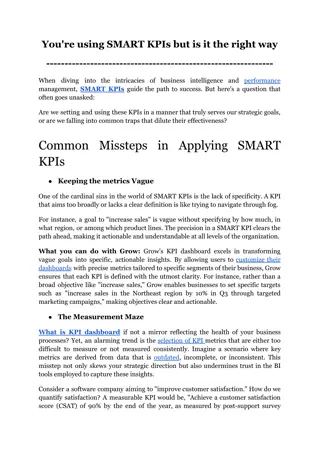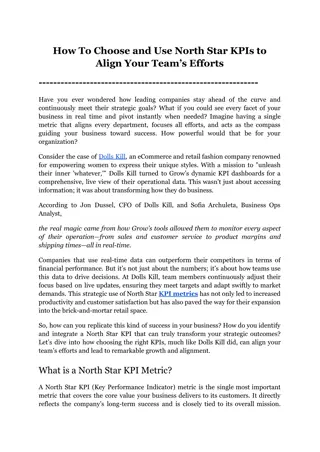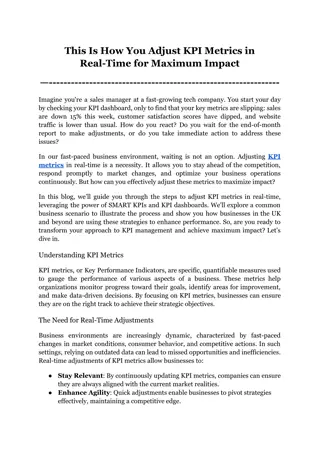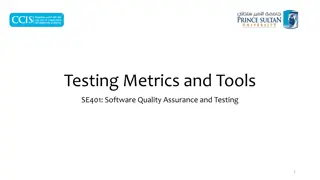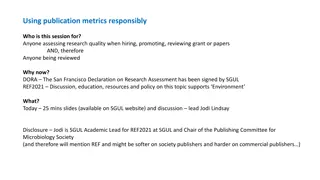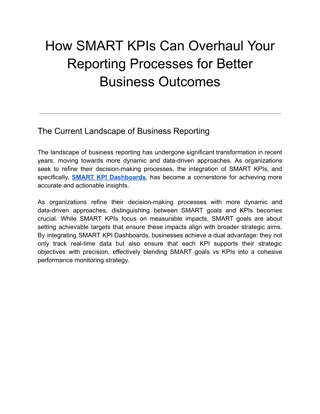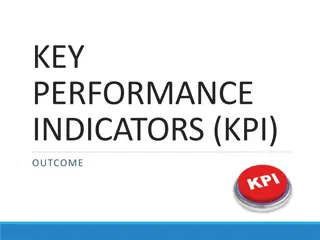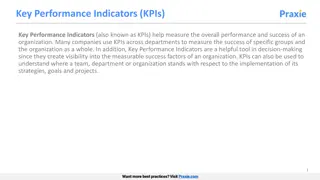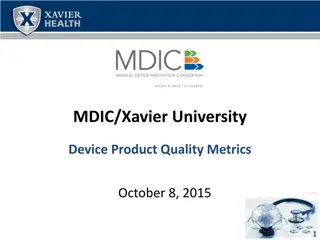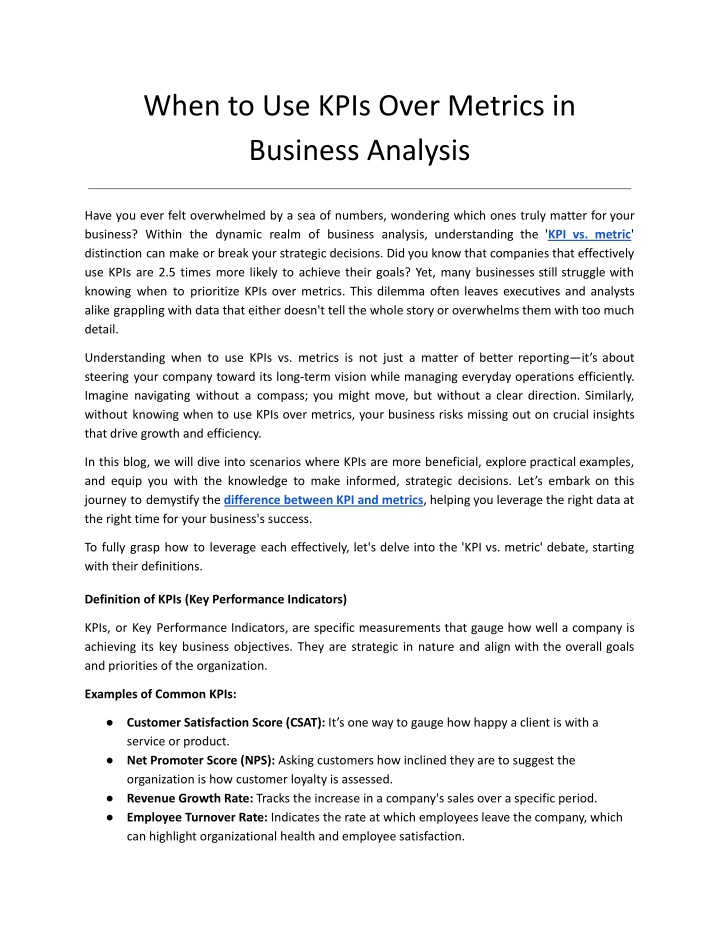
When to Use KPIs Over Metrics in Business Analysis
Are you struggling to differentiate between the sea of metrics and the strategic value of KPIs in your data-driven decisions? Uncover the pivotal moments when prioritizing KPIs over mere metrics can transform your business analysis from routine to re
Download Presentation

Please find below an Image/Link to download the presentation.
The content on the website is provided AS IS for your information and personal use only. It may not be sold, licensed, or shared on other websites without obtaining consent from the author. If you encounter any issues during the download, it is possible that the publisher has removed the file from their server.
You are allowed to download the files provided on this website for personal or commercial use, subject to the condition that they are used lawfully. All files are the property of their respective owners.
The content on the website is provided AS IS for your information and personal use only. It may not be sold, licensed, or shared on other websites without obtaining consent from the author.
E N D
Presentation Transcript
When to Use KPIs Over Metrics in Business Analysis Have you ever felt overwhelmed by a sea of numbers, wondering which ones truly matter for your business? Within the dynamic realm of business analysis, understanding the 'KPI vs. metric' distinction can make or break your strategic decisions. Did you know that companies that effectively use KPIs are 2.5 times more likely to achieve their goals? Yet, many businesses still struggle with knowing when to prioritize KPIs over metrics. This dilemma often leaves executives and analysts alike grappling with data that either doesn't tell the whole story or overwhelms them with too much detail. Understanding when to use KPIs vs. metrics is not just a matter of better reporting it s about steering your company toward its long-term vision while managing everyday operations efficiently. Imagine navigating without a compass; you might move, but without a clear direction. Similarly, without knowing when to use KPIs over metrics, your business risks missing out on crucial insights that drive growth and efficiency. In this blog, we will dive into scenarios where KPIs are more beneficial, explore practical examples, and equip you with the knowledge to make informed, strategic decisions. Let s embark on this journey to demystify the difference between KPI and metrics, helping you leverage the right data at the right time for your business's success. To fully grasp how to leverage each effectively, let's delve into the 'KPI vs. metric' debate, starting with their definitions. Definition of KPIs (Key Performance Indicators) KPIs, or Key Performance Indicators, are specific measurements that gauge how well a company is achieving its key business objectives. They are strategic in nature and align with the overall goals and priorities of the organization. Examples of Common KPIs: Customer Satisfaction Score (CSAT): It s one way to gauge how happy a client is with a service or product. Net Promoter Score (NPS): Asking customers how inclined they are to suggest the organization is how customer loyalty is assessed. Revenue Growth Rate: Tracks the increase in a company's sales over a specific period. Employee Turnover Rate: Indicates the rate at which employees leave the company, which can highlight organizational health and employee satisfaction.
Definition of Metrics Metrics are quantifiable measures used to track and assess the status of specific business processes. Unlike KPIs, metrics are more granular and operational, providing detailed insights into day-to-day activities. Examples of Common Metrics: Website Traffic: Monitors the number of visitors to a company's website. Conversion Rate: The proportion of visitors who go on to do the intended action, like buying something. Average Handle Time (AHT): Tracks the average duration of customer service calls. Inventory Turnover: Measures the frequency of sales and replacements of inventory over a given time frame. Exploring the 'KPI vs. Metric' Debate: Key Differences Understanding the difference between metrics and KPIs is vital for effective business analysis. While both metrics and KPIs are used to measure performance, they differ in scope, purpose, and impact. Scope and Focus: KPIs: Broad and strategic, focusing on long-term goals and overall business health. For example, a KPI in a dashboard might display the revenue growth rate, giving executives a clear picture of financial progress. Metrics: Specific and operational, dealing with the finer details of business processes. Metrics might track daily website traffic, offering insights into marketing effectiveness. Purpose and Usage: KPIs: Used to evaluate the success of an organization in reaching its key objectives. They help in strategic planning and decision-making. For instance, tracking the NPS can guide customer experience improvements. Metrics: Used to monitor and manage everyday business activities. They support operational adjustments and efficiency. Monitoring the average handle time can help optimize customer service operations. Impact and Decision-Making: KPIs: Have a significant impact on the strategic direction of the company. They influence high-level decisions and long-term strategies. The employee turnover rate KPI can prompt leadership to address workforce issues.
Metrics: Impact daily operations and short-term decisions. They help identify immediate issues and opportunities. A spike in inventory turnover might indicate a need to adjust supply chain practices. By distinguishing between metrics and KPIs, businesses can better utilize these tools to drive performance and achieve their objectives. Integrating both effectively can lead to more comprehensive and actionable insights, enhancing overall business intelligence. When to Use KPIs Over Metrics In business analysis, knowing when to prioritize KPIs over metrics is crucial for effective decision-making. While both metrics and KPIs provide valuable insights, they serve different purposes. KPIs are more beneficial in specific scenarios where strategic alignment and long-term planning are paramount. Long-Term Strategic Planning KPIs are instrumental in long-term strategic planning as they help organizations focus on their overarching goals. Unlike metrics, which often address immediate operational concerns, KPIs provide a clear vision of where the company is heading. For instance, setting annual growth targets is a common KPI used in strategic planning. It helps businesses forecast revenue, allocate resources, and set priorities for the coming year. By having a KPI in a dashboard that highlights revenue trends, customer acquisition rates, and other relevant factors, companies can keep their strategic objectives in sight and measure their progress effectively. Tracking Progress Towards Strategic Goals KPIs are designed to track progress towards strategic goals, offering a snapshot of how well the organization is performing against its objectives. This is crucial for ensuring that all efforts are aligned with the company's vision. Monitoring customer satisfaction over time is a KPI that can indicate whether initiatives to improve customer experience are effective. It provides insights into customer loyalty and areas needing improvement. For example, a retail company might use customer satisfaction (CSAT) scores as a KPI to monitor feedback, identify pain points, and implement changes to enhance the customer experience. This kind of ongoing monitoring through KPIs helps businesses stay on course and make informed adjustments to their strategies. Aligning Teams with Overall Business Objectives KPIs help align teams with the company's overall business objectives, ensuring that everyone is working towards the same goals. This alignment is essential for maintaining focus and fostering collaboration across departments. Evaluating employee performance in line with company goals is a KPI that ensures individual and team efforts are contributing to the organization's success. For instance, a financial services firm might set KPIs related to employee performance, such as project
completion rates and client satisfaction scores, to assess individual contributions to overall business goals. By doing so, the firm can promote accountability, recognize achievements, and ensure that efforts are aligned with strategic objectives. Examples of Effective KPI Usage Setting annual growth targets is a common scenario where KPIs prove invaluable. For example, a tech startup aiming to increase its market share by 20% over the next year can track its progress, adjust strategies, and ensure that all teams are contributing to this goal by setting annual growth targets as a KPI. This approach provides a clear benchmark for success and helps in resource allocation and strategic adjustments. Monitoring customer satisfaction over time is another effective use of KPIs. A retail company looking to improve its customer service can use CSAT scores as a KPI to monitor feedback, identify pain points, and implement changes to enhance the customer experience. This ongoing tracking through key performance indicators provides practical understanding of consumer happiness and loyalty, enabling ongoing enhancement. Evaluating employee performance in line with company goals is crucial for strategic alignment. For instance, a financial services firm might set KPIs related to employee performance, such as project completion rates and client satisfaction scores, to ensure individual contributions align with overall business goals. This approach promotes accountability and recognizes achievements, aligning individual and team efforts with strategic objectives. Integrating KPIs and Metrics for Comprehensive Business Analysis As far as business analysis is concerned, a balanced approach to using both KPIs and metrics is essential for gaining a holistic view of organizational performance. While metrics give granular information about operations, key performance indicators (KPIs) give insights into the big picture. By integrating both, businesses can ensure they are not only achieving their long-term goals but also maintaining day-to-day efficiency. Importance of a Balanced Approach A balanced approach to integrating KPIs and metrics ensures that an organization can track its strategic objectives while also monitoring the finer details of its operations. Understanding the difference between KPI and metrics is crucial in this context. KPIs (Key Performance Indicators) provide high-level indicators of success and progress towards strategic goals, while metrics offer detailed insights into specific processes and activities. For example, having KPIs in a dashboard allows executives to monitor overall performance, while metrics can highlight areas needing immediate attention. This balance ensures that businesses can make informed decisions at both strategic and operational levels.
Strategies for Integrating KPIs and Metrics Effective integration of KPIs and metrics requires clear strategies. Firstly, aligning KPIs and metrics with business objectives is fundamental. Each KPI should be directly linked to a strategic goal, and relevant metrics should support these KPIs by providing detailed data. For instance, if a KPI is to increase customer satisfaction, metrics such as response time, resolution rate, and customer feedback scores can provide the necessary insights to achieve this goal. Secondly, creating comprehensive dashboards that include both KPIs and metrics helps visualize data effectively. A well-designed dashboard can display KPIs alongside supporting metrics, offering a holistic view of performance. This integration allows for quick identification of trends, anomalies, and areas for improvement. Thirdly, regular review and adjustment of KPIs and metrics are vital. Business environments are dynamic, and what is measured should evolve with changing objectives and conditions. Periodic reviews ensure that KPIs and metrics remain relevant and aligned with current business priorities. Tools and Technologies for Effective KPI and Metric Management Leveraging the right tools and technologies is key to managing KPIs and metrics effectively. Business Intelligence (BI) platforms like Grow provide robust solutions for integrating and visualizing metrics and KPIs. These platforms offer customizable dashboards, real-time data updates, and advanced analytics capabilities. Grow s BI platform, for instance, allows businesses to create dynamic dashboards that integrate KPIs and metrics seamlessly. Users can customize views, set up automated reports, and use advanced analytics to gain deeper insights. The platform's flexibility ensures that it can adapt to various business needs, from tracking high-level strategic goals to monitoring specific operational metrics. Conclusion Integrating metrics and KPIs for comprehensive business analysis is crucial for achieving both strategic and operational excellence. A balanced approach ensures that businesses can monitor their long-term goals while maintaining day-to-day efficiency. By leveraging strategies for alignment, creating comprehensive dashboards, and using advanced BI tools like Grow, businesses can enhance their decision-making processes. Explore how Grow s BI platform can help you integrate KPIs and metrics in dashboards, providing the insights needed to optimize both strategic and operational performance. Visit our website to start your 14-day free trial and discover Grow s features and capabilities on GetApp today. Original Source: https://bit.ly/3ylztHI

